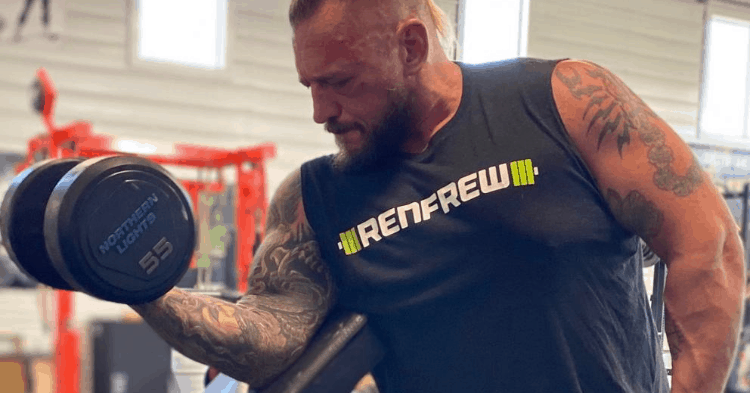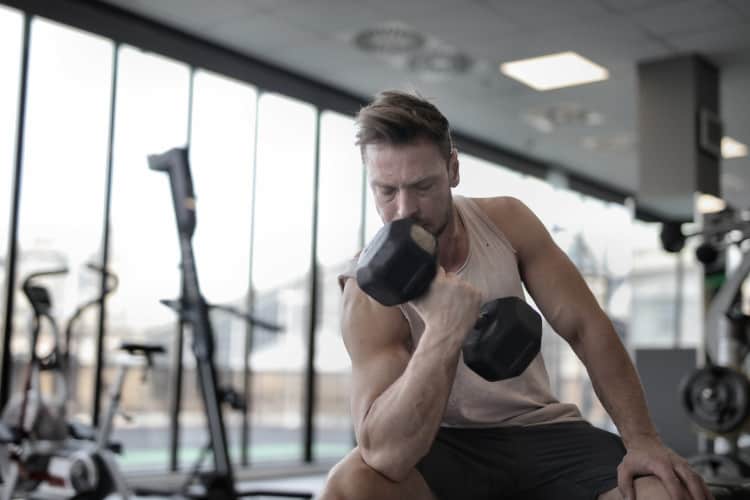It is not uncommon for one bicep to be bigger than the other, and there are a number of reasons why this can happen. One of the most common reasons is simply a difference in genetics — some people may naturally have one arm that is stronger or more muscular than the other. Another reason is differences in training — if you perform more exercises with one arm than the other, or if you favor one arm during exercises, this can lead to differences in muscle size and strength. While having one bicep bigger than the other is generally not a health problem, it can be a sign of an underlying issue in some cases. For example, if one arm is significantly weaker than the other, it could be a sign of nerve damage or a muscle disorder. If you are concerned about the size or strength of your biceps, it is important to speak with a healthcare professional to rule out any underlying health issues.

It’s normal for one arm to be bigger than the other. We do not work out both sides of our bodies equally which leads to uneven arms and biceps. The primary causes for uneven arm size are due to improper form, injuries, and natural dominance. It is possible to balance out arm and bicep size through body awareness and targeted unilateral exercises.
Bodybuilders run into a lot of challenges when pursuing their goals. While nutrition and recovery are common concerns, imbalances are a silent issue that often goes unaddressed. For many bodybuilders, the most notable imbalance is in arm size. If you have one bicep bigger than the other, you aren’t alone. Today, we’ll go over the causes of uneven arm size, how to correct it, and five exercises to try.
Contents
One arm bigger than the other, is it normal?
Yes, it is normal to have one arm bigger than the other. The human body is asymmetrical which leads to uneven body proportions. You may have one eye that’s slightly bigger than the other or one leg that’s a little longer. Such differences tend to be so subtle that they go undetected. Asymmetry is more noticeable as we increase muscle size. The main reason we notice asymmetry in muscle size is that we’re paying closer attention to our bodies and tracking progress. There are also preventable factors that could be influencing the variance and making the size difference more pronounced as time goes on.
Why is one bicep bigger than the other?

There are a few reasons why one bicep is bigger than the other. The three most common reasons include your dominant hand, underlying injuries, and improper training form, which we’ll discuss in detail below.
1. Dominant hand
One of the leading causes of one bicep being larger than the other is in relation to your dominant hand. You tend to use your dominant hand more throughout the day than your non-dominant hand. Daily tasks of carrying groceries or picking things up off the floor add up over time. The muscles in your dominant arm naturally get more exercise, causing the size difference.
2. Underlying injury
A second reason for an imbalance in bicep size is due to an underlying injury. A muscular or tendon issue that hasn’t healed properly can impact how your bicep looks while flexing. Tendon injuries are common and happen during seemingly mundane exercises. Carrying something the wrong way can snap a bicep tendon with relative ease. Overtraining can also lead to a torn bicep tendon, requiring you to prioritize rest and recovery.
When your bicep injury heals without corrective surgery, it will often reattach in the wrong place. This causes a bunched appearance, in which the muscle no longer extends from the shoulder to the elbow. As a result, the bicep looks significantly smaller than its counterpart.
3. Improper training form
Improper training form is another cause of one bicep being bigger than the other. Working with proper form has a significant impact on your training and affects how your muscles develop. You may be cheating your movements and allowing other body parts to pick up the slack without realizing it. It is called compensation when the muscles other than those you’re targeting take over the movement.
For example, your shoulders and traps might pick up the slack as you start to get tired while doing barbell curls. You no longer gain the desired effect even as you complete the movement because the wrong muscles are being activated. The same effect applies if one arm is stronger than the other. Your right arm will make up for the left arm’s weakness and bear the weight. As a result, the strong arm will continue to get stronger, making the difference that much more noticeable.
What to do if one bicep is stronger than the other

One bicep is stronger than the other typically coincides with your arm being larger than the other. Below are four tips to help equalize your uneven bicep strength.
1. Know your compensations
It’s essential to know your compensations to improve uneven bicep strength and size. Compensations refer to improper movements during training that activates the wrong muscles. The primary method to acknowledge your compensation is by being aware of your body movements during exercise. For example, lean against the wall for balance if you tend to cheat your movements during hammer curls and allow your back to do the work. By doing so, you prevent your body from making swinging motions that transfer the movement from the biceps to the traps. Use self-recorded videos or work with a coach to help identify imbalances and form improvement opportunities. It can also be helpful to train in front of a mirror during bicep exercises.
2. Use unilateral exercises
One of the most effective ways to even out the biceps is to use unilateral exercises. Work one arm at a time to isolate the biceps on each side. Swap out your barbell curls for dumbbell curls and use more single-arm bicep exercises. By taking this approach, you’ll prevent your strong arm from picking up the slack of your weak arm. You can also tweak your training and do a few extra reps on the weak arm to help build strength and muscle mass over time.
3. Slow down the movement
Slowing down your movements helps you target the right muscles and pace yourself appropriately. Physics plays a subtle role in training. Curling 20 lbs quickly can feel significantly different than curling 20 lbs slowly. There are a few factors contributing to these differences, the most prevalent of which is momentum. By slowing down the movement and adding torque, you can ensure the muscle is doing the work rather than momentum.
4. Use resistance bands
Resistance bands can help you balance out your biceps better than resistance bands. When you curl with a dumbbell, you may notice how much lighter the weight seems at the top of the movement. With a resistance band, the more you stretch it, the greater resistance. At the top of the concentric part of the movement, you’ll experience more resistance with a band. Conversely, the eccentric movement will become easier. This is known as flipping or inverting the strength curve, and can help balance out your biceps.
Exercises to do when one arm bigger is than other
1. Concentration curls

Concentration curls are an ideal exercise to try if one arm is bigger than the other. Concentration curls remove momentum from the equation and prevent the movement from shifting to the shoulders. This isolation allows bodybuilders to focus on each arm separately and correct bicep imbalances.
How to:
- Sit on a bench with your feet firmly planted on the ground. Hold a dumbbell in a supinated hold, with your elbow resting on your inner thigh.
- Slowly curl the weight upward toward your bicep— your upper arm should be stable with only your forearm moving.
- At the top of the movement, pause and squeeze your bicep.
- Slowly lower back to starting position.
Take your time and move through this exercise slowly for best results.
2. Single-arm preacher curl

Single-arm preacher curls are helpful for people with one arm bigger than the other. Single-arm curls work the biceps extensively. Preacher curls help prevent a shoulder shift when curling, similar to concentration curls.
How to:
- Sit at a preacher bench or lean over a bench adjusted to armpit height. Hold a dumbbell with an underhand grip and rest your arm on the bench, stopping just under the armpit.
- Slowly curl the weight up, keeping your upper arm fixed on the bench.
- When your forearm is perpendicular to the ceiling, pause and squeeze your bicep.
- Slowly lower back to starting position.
Single-arm preacher curls are a fantastic isolation exercise for targeting uneven biceps.
3. Incline dumbbell curl

Incline dumbbell curls are ideal for targeting the long head of the bicep. The increased range of motion sets the exercise apart from other curl variations. However, incline dumbbell curls will help even out arm size if done appropriately and in proper form.
How to:
- Adjust your bench to a 45-degree angle. Grab two dumbbells with an underhand grip, and sit back on the bench.
- Slowly curl one dumbbell, allowing only the forearm to move.
- At the top of the movement, pause and squeeze the bicep.
- Slowly lower the dumbbell back to starting position and repeat on the other side.
Being slow and controlled is the key to success with this movement.
4. Lying cable curl

Lying cable curls are another helpful exercise to combat uneven bicep size. Laying down for cable curls may seem strange, but it’s an effective way to prevent motion transfer and effectively target the biceps. When performed unilaterally, this exercise is a must when you have one bicep bigger than the other.
How to:
- Attach a straight bar or EZ bar to the low pulley cable machine. You can also use ropes or a D grip for unilateral movements.
- Lay on your back with your feet toward the cable pulley and grip the bar with an underhand grip, keeping your arms extended.
- Curl the bar upward toward your chest while keeping your upper arms tucked to your sides and still.
- Squeeze at the top of the motion and slowly lower back to starting position.
If you don’t have access to a cable machine, you can do this movement with a resistance band secured to a rack.
5. Single-arm reverse cable curl

The single-arm reverse cable curls are an often overlooked bicep exercise due to their simplicity. The movement starts out with a lightweight which can be deceptive. The exercise is effective if you have one arm bigger than the other due to the muscles it targets, however.
How to:
- Attach a D grip to the low pulley cable machine.
- Grab the handle with an overhand grip while facing the machine. Assume an athletic stance with feet at hip-width and knees slightly bent.
- Curl the weight up toward your shoulder, while keeping your elbows tucked and upper arm stable.
- At the top of the movement, pause, squeeze, and slowly lower back to starting position.
Brace your core and keep your chest up for this workout. Consider resting your inactive hand on your abdomen as a reminder to stay firm and stable.
Conclusion
It’s completely normal to have one arm bigger than the other. It’s also reasonable to want to know how to balance out your biceps for an even flex. Identify any issues that may be causing the imbalance. Next, use unilateral exercises and proper form to isolate each arm and correct the problems. With time and effort, your biceps will even out.